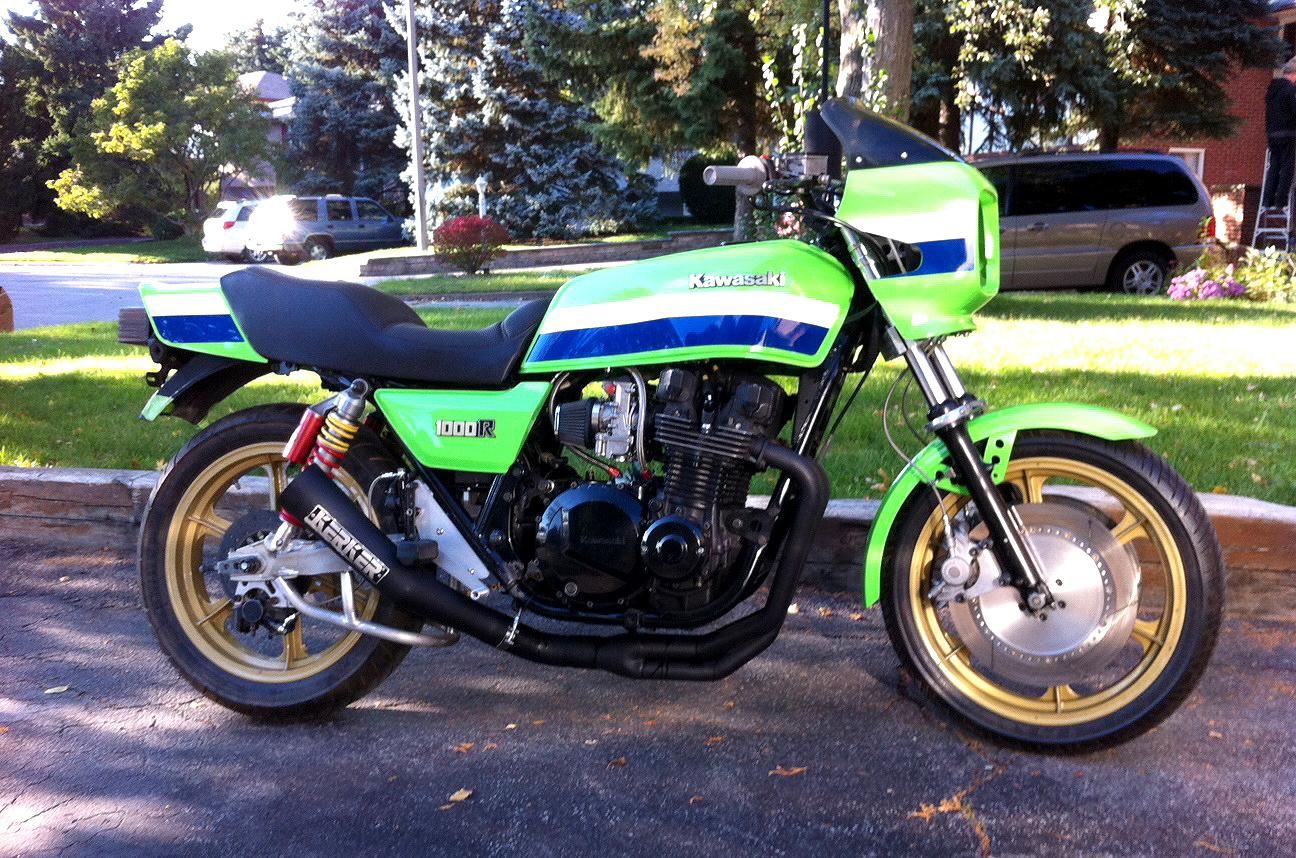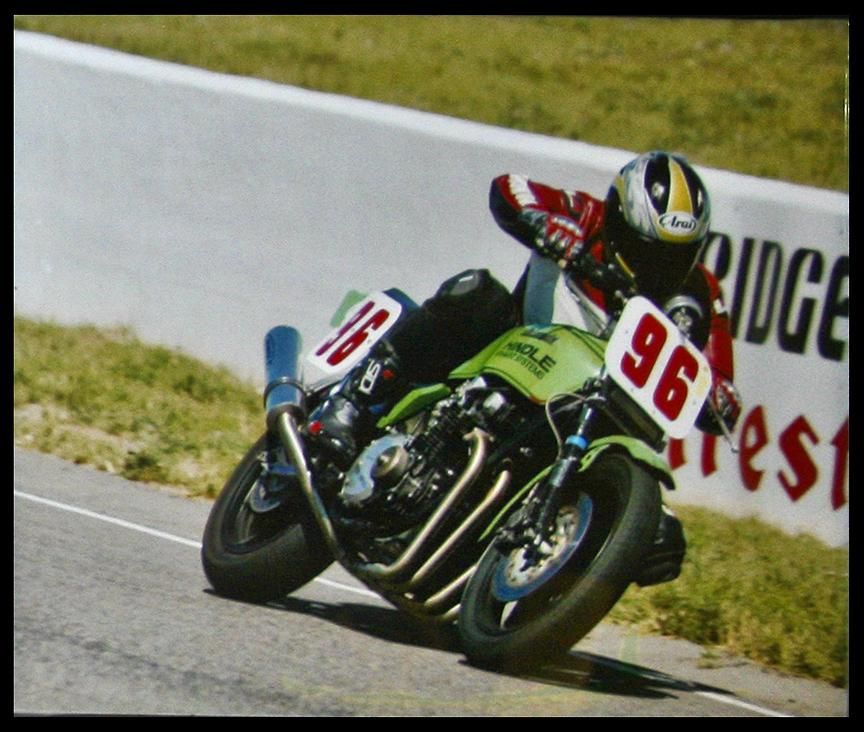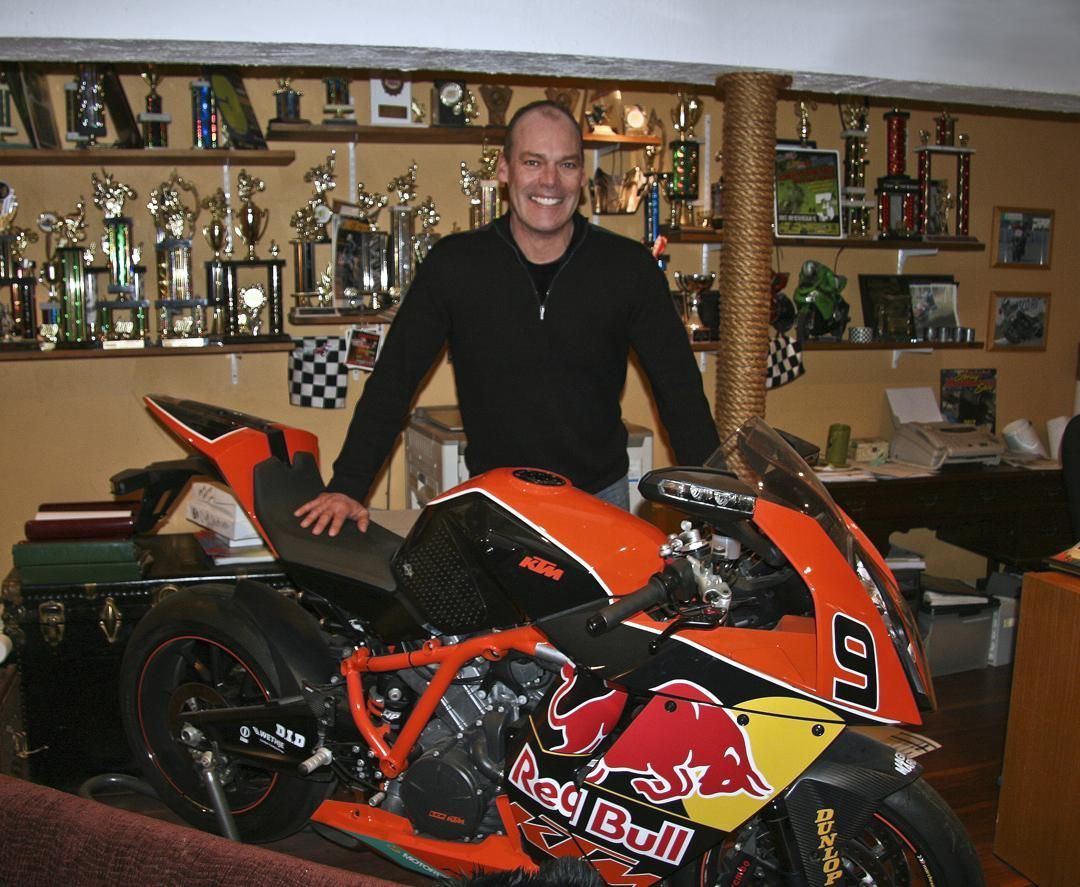Peter Derry: The Man, The Show, And The Inescapable Destiny
Smart, friendly, and adventurous, Peter Derry, Co-Owner and Vice President of Sales and Marketing of the International Spring Motorcycle Show is a natural motorcycle enthusiast.
Peter began racing motorcycles in 1980, when the Superbike Class was just born, and he competed until 1983. His son Ryan, a pro Motocross athlete, has been racing since the age of 5, with Peter as his micro-manager. When Ryan was around 8 years old, Peter thought, ‟Why am I standing on the sidelines? I'm going to get my own bike and start moto-ing”. And that's exactly what he did.
In 2002 Peter was asked to race Lang Hindle's superbike in the Vintage Series and he set 2 lap records at Mosport International Raceway.

Peter and his son take on the track (top) and Peter races the Hindle Superbike and sets a record
Peter's regular street bike is a Kawasaki Ninja ZX12R, and he has just finished restoring a brilliant green 1984 Kawasaki 1100R that, although modified for racing, is purposed for the street, and affectionately termed by Peter as the ‟Sunday Hotrod”. His recent acquisition is a beautiful 2010 KTM RC8R 1190.
‟I'm so excited cause I've got that green bike that I've finished building and it's ready to go… like ready. Turn the key and brrrrooom… gone! That bike, the KTM, it's ready to go. I've never been in the position where I have two bikes ready to go. I've been building that one [Kawasaki] for 4 years, and that one [KTM], well that one I didn't even think about buying… so now that I have it I'm like a kid in a candy store!” he says with a grin.

The bike that Peter built, the Kawasaki 1000R, his Sunday Hotrod
Peter's love of riding began at an early age. At 10 he wanted a mini bike like the rest of his friends, but it wasn't until around the age of 15 that he was finally able to buy a ‟bike in a box” - an orange Kawasaki 175 2 stroke. He built it, sold it, and bought a Honda 175, and then a Kawasaki H Triple, and so on it went.
With high school finished, Peter started racing then shortly after went on to be a mechanic working for various icons in the industry like John Pugh from Cycleworld Superstore, Toronto Motorbike (aka ‟Toronto Murderbike”), and Bob Sutherland's Do It Yourself Repair Center. It was through Bob Sutherland that he met Bar Hodgson, his good friend and current partner in the ownership of the Spring Motorcycle Show. The partnership was not to happen until several years later as Peter had made a decision to leave the motorcycle industry all together.
‟It was a long way from the day I decided that I was done being a motorcycle mechanic,” he explains. ‟It was Mississauga Suzuki. I was the Service Manager there. I wasn't able to utilize the methods and systems I felt that needed to happen there. So I grabbed my work boots, threw them in the bin… went over and got my tools in my van… my racebike… and said, 'That's it! I'm never gonna work in the motorcycle business again!'”
Peter began selling Jaguars. He got married, and then opened a gas station and garage in Newmarket. It wasn't long before his love of motorcycles caught up to him though, and he bought another bike. That purchase led him to Steve Prover, who owned Competition Wheels. Steve asked Peter to help him with his business and Peter couldn't say no. He drew up a business plan and starting selling bikes.
During his time there he was introduced to Michael Taylor, a Superbike Champion who asked Peter to market him for sponsorship. It was marketing Michael that brought Peter into the sphere of the International Motorcycle Supershow, and back into the life of Bar Hodgson, motorcycle man of distinction and Hall of Fame inductee.
It did not take long before the men realized there might be a ‟fit” somewhere, so Peter began doing some freelance work for Bar Hodgson Productions in the form of generating sponsorship revenue for the Motorcycle Supershow held in January, as well as the Spring Motorcycle Show. That was in 1995.
A year later Peter and Bar started the Mosport Rally for Sportbikes. It began as a weekend affair and soon grew into a weeklong event that culminated into the National Rally for Superbike Series, all the while concurrently organizing around 12 track days per summer. In 2002 the event that they had built was given back to Mosport due to its size, and the insurance and liability issues that it subsequently created.

Peter Derry sets lap record on Hindle's Kawasaki KZ 1000 Superbike at Mosport Raceway
The two men continued to cultivate their working relationship and their friendship. ‟Bar and I are really very close,” describes Peter. ‟He's almost like a dad to me. He and I have worked together very, very hard… very closely. I'm at a level where he doesn't allow people to handle his motorcycles except for me. So, you know, he's taught me a lot.”
Bar soon dropped all revenue-oriented efforts and appointed Peter Vice President of the company, letting him run with it. And run with it he did! He took the Motorcycle Supershow from 3 halls to what it is now - 7 halls and 430,000 sq ft. It was anticipated that Peter would be Bar's successor in the ownership of the Supershow, however they had grown the show to the point that its value was astronomical. In light of that Peter decided to purchase 50% of the Spring Motorcycle Show instead. Peter Derry Productions Inc. remains responsible for the sales and marketing of the January Supershow.
Preparation for the shows begin as soon as they have ended, and Peter has recently been putting in 14 hour days getting ready for the Spring Motorcycle Show taking place this year on Saturday and Sunday, March 16 & 17, 2013.
‟This show is coming along very well,” he says. ‟The word is spreading nicely and the exhibitor base is excited. The manufacturers are endorsing it… I'm really encouraged by it.”
Some of the challenges for Peter in pulling the show together are the time pressures and stress factors. It's about keeping himself on track and keeping the balls he's juggling in the air. It's about ensuring he's not letting anything slide. Last year the show had very few show bikes and Peter determined that that wasn't going to happen again. Currently they have over 30 show bikes lined up for this year.
‟In every aspect of the show you wanna make sure it's 10% better, cause all those things added up make for a huge improvement.
You work all year on it because you gotta have your ear to the ground in this industry and know what's going on. You know, there are projections that you have to be making so you can set goals for your next year. And that's all based on what's happening in the economy and in the motorcycle industry… cause those two, while you'd think are directly tied and directly proportional… um, sometimes aren't. It's kind of odd.”
He continues, ‟Because motorcycling is so passion-oriented it takes people that are very mechanical and it gets their interest. And it takes people that are very artsy and it gets their interest. And right now it's getting big enough that the artsy people are getting into the motorcycle industry. They're buying the Moto Guzzis. They're buying the Vespa… you know, the retro look. They're embracing the new rocker style. That's who these new people are and we need to welcome them. We need to say, 'Great! C'mon in. Let's share. I like what you're doing' and whatever. That's what the show's all about. It's about everything in motorcycling. It's recognizing those things that are happening, and cultivating them, and encouraging them to happen anyway you can.”
Bar Hodgson birthed the Spring Motorcycle Show in 1988, and in its inception it differed from the January Supershow. ‟It's more of a 'classic' bike show. Bar's had that affinity with classic motorcycles, so that's really the focus of it. And there again, because of my involvement, I was able to work on it and build it and it evolved to a bigger and bigger show… you know, we got more and more and more industry into it.
The two shows are not unlike each other,” Peter goes on to say. ‟They really are very similar format. And so the Spring Show, by moving it to March [from April] we thought we could better attract the core motorcycle industry. So that meant getting GP Bikes in with a nice big display. They do a display in our show that I believe is the largest motorcycle show exhibit that they do. It's larger than the Supershow.”
Attendance at the Spring Motorcycle Show is roughly around 20,000, and vendor booth rates are very affordable. As Peter puts it, ‟It is a lot more accessible to the Ma and Pa's. You know, the small bike shops that are just trying to get going. It's attainable for them.
And the timing's better now. So having done all this it's now able to grow in leaps and bounds. We've had Honda Canada book exhibit space with us, and we're in the process right now of finalizing exhibit space for Kawasaki Canada.”
When asked about the future of the Spring Motorcycle Show, Peter had this to say, ‟It's good timing. There's lots of room for it to expand and grow and thrive.
You know,” he expounds, ‟motorcycling… what a word. It will strike fear in some people's hearts. It will make them flush with excitement... but it does something to everyone. It's a very passionate thing, and the people that embrace motorcycling, they're gonna go to motorcycle shows. It's part of the culture. It's an aspect of being a motorcyclist. And you go and see your friends there. That's what my show - our show - is about.”

Peter Derry and his 1190 KTM RC8R
You must be logged in to comment
Login now